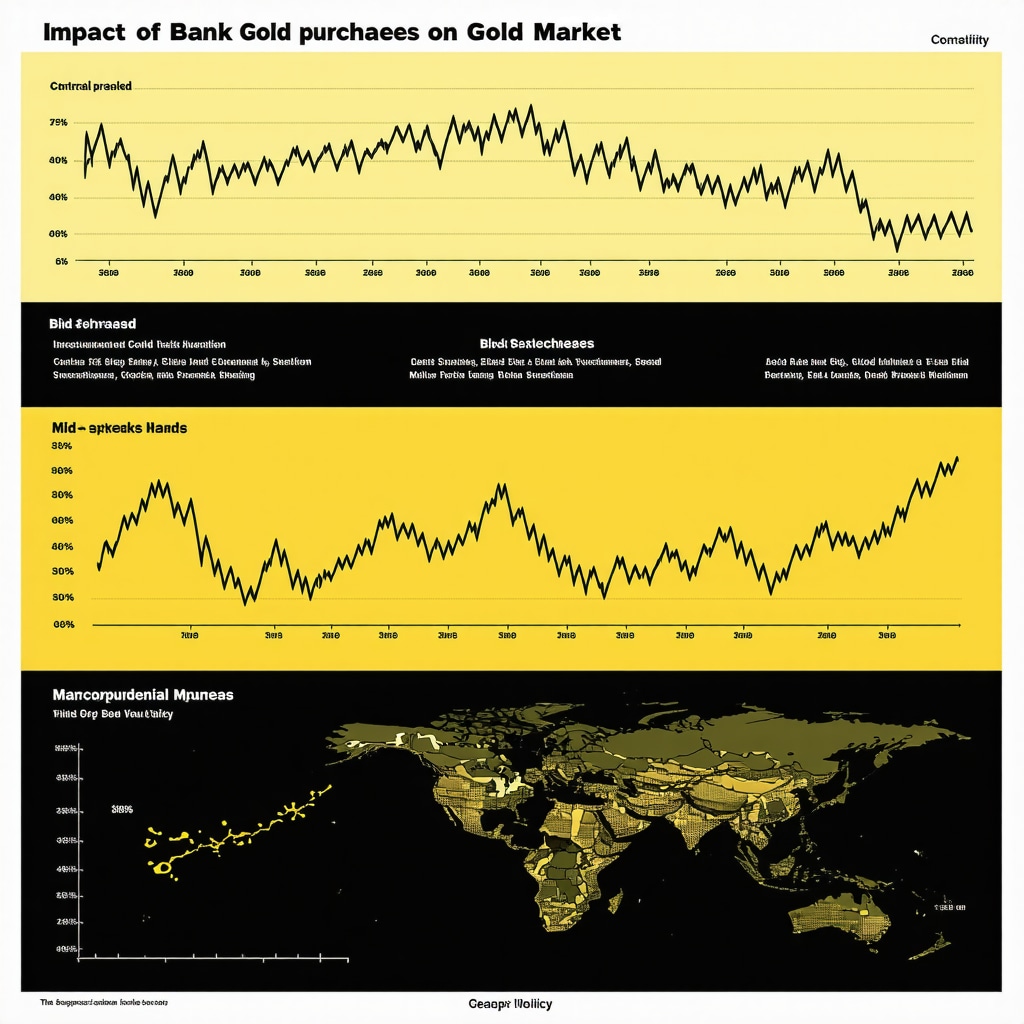Strategic Implications of Central Bank Gold Purchases on Global Gold Markets
The resurgence of central bank gold buying over recent years has introduced a pivotal dynamic into the global gold market, fundamentally shaping price trajectories and investor expectations for 2025. Historically, central banks have oscillated between selling and accumulating gold reserves, but the current trend towards aggressive accumulation signals strategic repositioning amidst geopolitical uncertainties and inflationary pressures. This shift not only alters supply-demand equilibria but also impacts market sentiment and liquidity conditions, necessitating a nuanced understanding for investors forecasting gold prices in 2025.
Mechanisms by Which Central Bank Acquisitions Influence Gold Price Trends
Central banks typically acquire gold to diversify reserves, hedge against currency debasement, and bolster financial sovereignty. Their substantial purchases reduce available market supply, exerting upward pressure on prices. Moreover, these transactions often signal confidence in gold as a safe-haven asset, thereby amplifying speculative demand. The interplay between official sector buying and private investment flows creates complex market feedback loops that can accelerate price momentum or induce volatility depending on macroeconomic contexts.
How Do Central Bank Gold Buying Patterns Affect Investor Strategies for 2025?
Investor strategies in 2025 must account for the nuanced signals embedded in central bank buying behavior. For instance, sustained accumulation by emerging market central banks may indicate shifts in global economic power and reserve diversification priorities, prompting investors to reevaluate gold’s role in portfolios. Additionally, understanding the timing, scale, and geopolitical motivations behind these purchases can guide tactical allocations across physical gold, ETFs, and mining equities, aligning with anticipated price movements and risk profiles.
Advanced Analytical Perspectives: Integrating Central Bank Activities with Gold Market Forecast Models
Integrating central bank gold purchase data into quantitative forecasting models enhances predictive accuracy for 2025 price outlooks. Variables such as net official sector buying volumes, currency reserve composition changes, and geopolitical risk indices can be incorporated into econometric and machine learning frameworks to simulate future price scenarios. This approach enables investors and policymakers to discern the causal relationships between official sector behavior and market dynamics, providing a robust foundation for strategic decision-making.
For deeper insights into how central bank gold purchases influence market dynamics and price forecasts, readers are encouraged to explore the comprehensive analysis on central bank gold buying influences.
Call to Action: Engage with Expert-Level Gold Market Analysis and Forecast Discussions
To further refine your understanding and investment approach, consider contributing to expert forums and accessing advanced resources on key factors impacting 2025 gold price trends. Participating in these discussions will enhance your strategic positioning in anticipation of evolving market conditions influenced by central bank activity.
Reference: World Gold Council, “Central Banks and Gold Reserves: Trends and Implications,” 2023. https://www.gold.org/goldhub/research/central-banks-and-gold-reserves
Unpacking the Impact of Central Bank Gold Buying on Gold Market Liquidity and Volatility
While central bank gold purchases are often perceived as bullish signals for gold prices due to reduced supply, their impact on market liquidity and price volatility deserves deeper scrutiny. Large-scale acquisitions can tighten liquidity in the physical gold market, potentially leading to sharper price swings during periods of geopolitical stress or monetary tightening. This dynamic challenges traditional assumptions that central bank buying unequivocally stabilizes gold prices. Instead, investors must anticipate periods where official sector activity may amplify market volatility, requiring adaptive risk management strategies.
Emerging Geopolitical Drivers Behind Central Bank Gold Accumulations in 2025
Geopolitical realignments continue to influence central bank gold acquisition patterns. Countries facing sanctions, currency instability, or shifting trade alliances are increasingly diversifying reserves away from dominant reserve currencies by accumulating gold. This trend is particularly visible in emerging economies seeking financial sovereignty amid global uncertainties. Understanding these geopolitical catalysts provides investors with a strategic lens to forecast gold demand shifts and price inflection points, enhancing portfolio resilience.
Can Understanding Central Bank Gold Buying Behavior Unlock Superior Portfolio Allocation in 2025?
For portfolio managers and sophisticated investors, decoding the nuances of central bank gold purchasing trends represents an underutilized advantage. By integrating official buying signals with macroeconomic indicators and geopolitical risk assessments, investors can optimize allocations across physical gold, gold ETFs, and mining equities. This multi-asset approach can capture price upside while managing downside risk, especially in volatile market environments characteristic of 2025. Such strategic positioning requires continuous monitoring of central bank disclosures and emerging market dynamics.
Experts at the World Gold Council emphasize that “Central bank buying in 2025 is not just a price driver; it is a strategic indicator of global economic shifts and financial risk appetite.”1 Incorporating this perspective into investment frameworks elevates decision-making quality.
Leveraging Machine Learning in Forecasting Gold Price Movements Influenced by Central Bank Activity
Advanced technology, including machine learning algorithms, offers powerful tools to dissect complex interactions between central bank gold purchases and gold price trajectories. By analyzing vast datasets encompassing official reserve changes, market sentiment, and geopolitical events, these models can identify non-linear patterns and potential turning points with greater precision than traditional econometric methods. Investors equipped with such analytical capabilities stand to enhance forecasting accuracy and refine entry-exit timing strategies.
For those interested in practical applications of these forecasting techniques, the key factors impacting 2025 gold price trends provide an excellent resource to deepen understanding.
Expert Insight: Navigating the Complexities of Central Bank Gold Buying for 2025 Success
Given the multifaceted nature of central bank gold purchases and their market implications, a comprehensive strategy entails diversifying exposure across various gold investment vehicles. Physical gold offers tangible security, while ETFs provide liquidity and ease of trading. Simultaneously, mining stocks can offer leveraged upside but come with operational risks. Balancing these elements in light of evolving central bank behaviors ensures investors remain agile and well-positioned.
To further refine your investment approach, consider exploring our detailed guides on comparing gold ETFs and stocks for portfolio growth and step-by-step investing in gold for beginners in 2025.
Invitation to Engage: Share Your Thoughts on Central Bank Gold Buying Trends
How do you perceive central bank gold purchasing will influence your gold investment strategy in 2025? Share your insights or questions in the comments below to engage with a community of experts and enthusiasts dedicated to mastering gold market complexities.
1 World Gold Council, “Central Bank Gold Reserves: Trends and Strategic Implications,” 2023. https://www.gold.org/goldhub/research/central-banks-and-gold-reserves
Decoding Liquidity Dynamics: How Central Bank Gold Buying Reshapes Market Fluidity and Trader Behavior
Central bank gold purchases, while often linked to bullish price signals, intricately affect market liquidity and trader behavior—a dimension frequently underestimated. Bulk acquisitions by official institutions can constrict the available supply of physical gold, resulting in thinner liquidity layers especially in spot and futures markets. This contraction can heighten bid-ask spreads and amplify slippage risk for large transactions, ultimately altering the price discovery process. Traders operating in such environments may face increased volatility spikes, particularly during geopolitical upheavals or central bank policy shifts, necessitating adaptive trading strategies that incorporate liquidity risk analytics.
Moreover, the concentration of gold holdings within central banks reduces the volume of gold that circulates freely among private investors and dealers. This phenomenon can exacerbate short-term price gyrations as market participants react to supply shocks or unexpected central bank disclosures. Sophisticated investors must therefore monitor official sector buying announcements in tandem with global monetary policy developments to anticipate liquidity-driven price movements effectively.
Unraveling Geopolitical Catalysts Behind Central Bank Gold Accumulation Patterns in 2025
The geopolitical landscape in 2025 continues to serve as a powerful driver of central bank buying behaviors. Nations confronting economic sanctions, currency destabilization, or evolving trade alliances increasingly diversify their reserve assets by bolstering gold holdings. This trend reflects a strategic pursuit of financial sovereignty and reduced dependence on dominant reserve currencies such as the US dollar or Euro.
Emerging economies like India, China, and several Middle Eastern countries have demonstrated pronounced gold accumulation, signaling shifts toward multipolar reserve currency regimes. These central banks leverage gold not only as a hedge against inflation but also as a geopolitical tool to insulate their economies from external shocks. Understanding these geopolitical undercurrents offers investors a nuanced perspective on supply-demand shifts and potential inflection points in gold pricing.
How Can Investors Leverage Central Bank Gold Buying Insights to Optimize Portfolio Risk-Reward in 2025?
For portfolio managers aiming to harness central bank gold buying dynamics, a multi-faceted approach is paramount. First, integrating real-time data on official sector purchases with macroeconomic indicators—such as currency volatility indices and geopolitical risk scores—can refine timing and sizing of gold allocations. Second, diversifying exposure across physical gold, exchange-traded funds (ETFs), and selective mining equities allows for tactical flexibility amid market fluctuations induced by official buying activities.
Additionally, advanced quantitative models incorporating central bank buying patterns can identify non-linear price responses, enabling investors to capitalize on momentum shifts or hedge against downside risks. Notably, the World Gold Council’s 2023 research underlines the strategic role of central bank purchases as both a price driver and a barometer of global economic power realignments1. Incorporating such expert insights into portfolio construction elevates decision-making sophistication.
To extend your expertise on this topic, explore our detailed resource on key factors impacting 2025 gold price trends and engage with ongoing expert analyses in our forums.
1 World Gold Council, “Central Banks and Gold Reserves: Trends and Implications,” 2023. https://www.gold.org/goldhub/research/central-banks-and-gold-reserves
Decoding the Subtle Shifts in Gold Market Microstructure Due to Central Bank Reserves Expansion
Beyond the apparent price effects, central bank gold acquisitions subtly recalibrate the microstructure of gold markets. The concentration of bullion within official reserves diminishes the floating supply accessible to market makers and arbitrageurs, thereby compressing market depth. This contraction alters liquidity provisioning, increasing the cost of immediacy and elevating bid-ask spreads, especially in times of stressed market conditions. Such microstructural shifts necessitate refined trading algorithms and liquidity management practices to mitigate execution risks in gold futures and spot segments.
Geopolitical Nuances: The Strategic Role of Gold in Emerging Multipolar Reserve Systems
As global economic power decentralizes, gold’s role transcends traditional monetary hedging, becoming a geopolitical instrument for emerging powers. Nations in Asia, the Middle East, and parts of Africa strategically accumulate gold to fortify reserve diversification against dollar-centric vulnerabilities. This geopolitical calculus integrates gold into broader sovereign wealth management frameworks, reflecting an evolution from passive reserve holding to active geopolitical signaling. Understanding these nuanced motivations enriches investor perspectives on gold demand trajectories and price formation mechanisms.
How Do Central Bank Gold Purchases Interact with Macroprudential Policies to Influence Global Financial Stability?
Central bank gold buying is increasingly intertwined with macroprudential regulatory frameworks aimed at safeguarding economic resilience. For instance, gold accumulation can serve as a buffer against currency volatility and capital flight, complementing capital control measures and monetary policy adjustments. This interplay influences cross-border capital flows and exchange rate stability, indirectly impacting gold price volatility and correlation dynamics with other asset classes. Sophisticated investors must therefore contextualize gold market signals within broader macroprudential policy environments to optimize portfolio hedging strategies.
Authoritative insights on this subject are detailed in the World Gold Council’s comprehensive 2023 report on central bank gold reserves, which elucidates the complex interdependencies between official gold purchases, monetary policies, and market stability.
Harnessing Quantitative and Sentiment Analytics to Decode Central Bank Gold Acquisition Signals
Advanced investors increasingly employ hybrid analytics combining quantitative reserve data with sentiment analysis extracted from central bank communications and geopolitical news flows. This multidimensional approach enables the anticipation of subtle shifts in central bank buying intentions before official disclosures, providing tactical advantages in timing market entries. Sentiment-infused machine learning models, calibrated with macroeconomic indicators and reserve transaction volumes, can uncover leading indicators of gold price inflection points driven by official sector behavior.

Integrating Multi-Asset Gold Exposure Strategies Amid Central Bank-Induced Market Dynamics
Given the complex ramifications of central bank gold purchases, a multi-asset allocation approach is imperative. Combining physical bullion holdings with strategically selected ETFs and mining equities allows investors to balance liquidity needs, capital appreciation potential, and operational risk exposure. Additionally, integrating derivative instruments such as options can offer asymmetric risk profiles aligned with anticipated volatility regimes shaped by central bank activity. This layered strategy enhances resilience and capitalizes on nuanced price dynamics in 2025.
Invitation: Deepen Your Expertise on Central Bank Gold Trends and Market Innovations
Elevate your investment acumen by engaging with our advanced analytical resources and expert forums dedicated to dissecting central bank gold buying patterns and their market implications. Explore cutting-edge research and collaborate with specialists to refine your strategic approach in navigating the intricate gold market landscape of 2025 and beyond.
Expert Insights & Advanced Considerations
Central Bank Gold Accumulation Signals Strategic Economic Realignment
Central bank gold purchases in 2025 are not merely tactical reserve adjustments but reflect a broader strategic repositioning amid shifting geopolitical power centers. This trend suggests emerging economies are actively seeking to reduce reliance on traditional reserve currencies, embedding gold deeper into monetary sovereignty frameworks. Investors who recognize this macroeconomic signal can better anticipate sustained upward pressure on gold prices and enhanced volatility driven by geopolitical catalysts.
Liquidity Constraints Induced by Official Sector Buying Require Adaptive Trading Approaches
As central banks amass gold reserves, the floating supply diminishes, compressing market liquidity and increasing bid-ask spreads. This evolving microstructure demands that traders and portfolio managers integrate liquidity risk analytics and adjust execution strategies accordingly, especially during periods of heightened geopolitical tension or monetary policy shifts. Understanding these subtleties can mitigate slippage risks and optimize timing in gold futures and spot markets.
Integrating Quantitative and Sentiment Analytics Enhances Forecasting Precision
Combining real-time central bank purchase data with sentiment analysis derived from official communications and geopolitical news flows offers a sophisticated edge in anticipating gold price inflection points. Machine learning models leveraging these hybrid datasets uncover nuanced patterns and enable proactive tactical positioning. Investors employing these advanced techniques position themselves at the forefront of predictive accuracy in the complex gold market environment of 2025.
Multi-Asset Gold Exposure Balances Risk and Opportunity Amid Market Complexity
A diversified approach across physical bullion, ETFs, mining equities, and derivatives is essential to capture the multifaceted impacts of central bank gold buying. This strategy aligns liquidity preferences, capital appreciation potential, and risk tolerances with the nuanced price dynamics and volatility regimes shaped by official sector activity. Strategic allocation adjustments informed by ongoing analysis of central bank behavior can enhance portfolio resilience and growth prospects.
Curated Expert Resources
- World Gold Council’s Central Banks and Gold Reserves Report (2023): An authoritative source providing comprehensive data and analysis on official gold buying trends and their strategic implications for global markets. Access the report here.
- BuyingGoldNow’s 2025 Gold Price Forecast Analysis: A detailed examination of key factors impacting gold price trends in 2025, integrating central bank activities with market dynamics. Explore the analysis.
- BuyingGoldNow’s Guide on Comparing Gold ETFs and Stocks: Insightful resource to optimize portfolio construction with balanced allocation across gold-related investment vehicles. Read the guide.
- BuyingGoldNow’s Step-by-Step Investing Guide for Beginners in 2025: A practical framework for newcomers to navigate gold investment options and strategies amid evolving market conditions. Start learning here.
- BuyingGoldNow’s Insights on How Central Bank Gold Buying Influences Market Dynamics: A focused exploration of official sector buying’s role in price formation and liquidity shifts. Discover more.
Final Expert Perspective
The interplay between central bank gold buying and global market dynamics in 2025 underscores a complex yet pivotal theme: gold is evolving beyond a mere hedge to become a strategic asset reflecting geopolitical realignments and monetary policy innovation. Recognizing the nuanced liquidity impacts, integrating advanced quantitative and sentiment analytics, and adopting a diversified multi-asset gold exposure strategy are essential for sophisticated investors aiming to capitalize on this evolving landscape. For those seeking to deepen their expertise and refine investment strategies, engaging with authoritative resources and ongoing expert discourse is indispensable. Share your professional insights or explore more advanced analyses on key factors impacting 2025 gold price trends to stay at the forefront of gold market intelligence.










